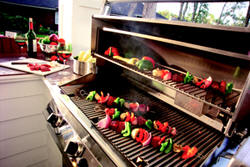Tips for Safe Grilling
 Read and follow all the grill manufacturer’s instructions before turning on and lighting the grill. Keep the top open when lighting a propane grill, and don’t close it until you are sure grill is lit.
Read and follow all the grill manufacturer’s instructions before turning on and lighting the grill. Keep the top open when lighting a propane grill, and don’t close it until you are sure grill is lit.- Season the meat before cooking and use a light hand. Whether you’re adding salt, pepper, or a custom rub, keep your hand about a foot above the meat to help distribute the spices evenly.
- Start with a hot grill. When you place meat on the grill, it should sizzle. Searing meat locks in the juices and flavor and helps keep meat from sticking to the grill. Turn the grill on as high as possible, then place the meat on the grate, close the lid, and sear one side for 3 to 4 minutes. Then, reduce heat to medium for the remainder of the cooking time.
- Most grilling is done with direct heat, or cooking items quickly at high temperatures. Place burgers, steaks, or your favorite tender beef cut directly over the grill burners. Use indirect heat when cooking less tender cuts of beef, such as brisket. The indirect low-and-slow method cooks meat at a lower temperature for a longer time. Simply turn off one set of burners and place beef on that side; radiant heat from the hot side will cook items slowly.
- Keep your beef from drying out. First, don’t flip the meat more than a few times — just once, if possible. Turning meat too often makes it lose its natural juices, leaving it flavorless and dry. Second, always use tongs or a spatula — not a fork — to turn meat. Piercing the meat allows its flavorful juices to escape.
- To make professional diamond grill marks, place the meat on the grill and sear it. After 3 to 4 minutes, turn it 90 degrees clockwise. Cook another two minutes, then flip and repeat.
- Most experts say cooking a steak to medium rare ensures the best flavor and tenderness. Cook to 140 degrees Fahrenheit for rare; 145 degrees for medium rare; 160 degrees for medium; and 170 degrees for well done. Ground beef and burgers should always be cooked to 160 degrees. Use an instant-read meat thermometer to ensure perfect results.
- When you’re finished cooking, remove the meat from the grill, put it on a clean plate, and let it rest for several minutes. Tent the clean plate loosely with foil to keep the meat warm. Letting cooked meat rest allows the juices to redistribute throughout the meat so they don’t escape after it is cut.
- Turn off the burner control and close the cylinder valve. When a grill is not in use for extended periods of time, cover disconnected hose-end fittings with plastic bags or protective caps to keep them clean.
- Properly transport and store gas cylinders. When refilling or replacing a propane cylinder, transport in a secure, upright (vertical) position in a well-ventilated area in your vehicle, and take it home immediately. Always use or store cylinders in a secure and upright position outdoors (not in a garage or shed).
DO
- • Follow the grill manufacturer’s instructions and keep written materials handy.
- • Keep the top of the grill open until you are sure it is lit.
- • Cover disconnected hose-end fittings with plastic bags or protective caps to keep a grill clean when it is not in use.
- • Store propane cylinders outdoors in an upright (vertical) position.
- • If you smell gas, safely turn off the cylinder valve, turning it to the right (clockwise). Immediately leave the area and dial 911 or call your local fire department. Before you use the grill again, have a qualified service technician inspect your cylinder.
DON’T
- Smoke while handling a propane cylinder.
- Use matches or lighters to check for propane leaks.
- Pour an accelerant such as lighter fluid or gasoline on the grill.
- Allow children to tamper with the cylinder or grill.
- Use, store, or transport propane cylinders near high temperatures (this includes storing spare cylinders near the grill).
- Try to be a grill repairman. If you are having grill or propane cylinder problems, see a qualified service technician.

